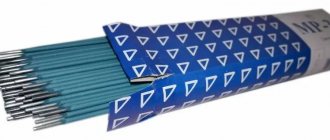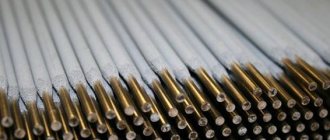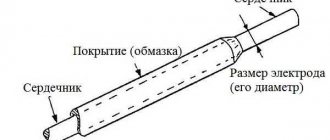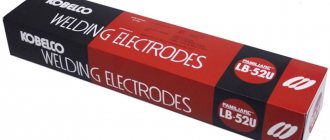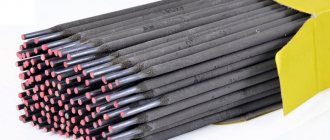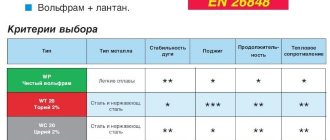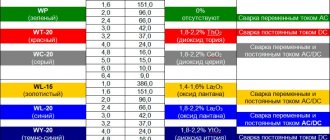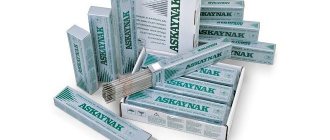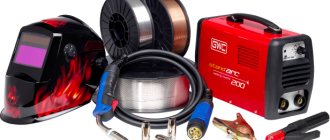Brands of electrodes for steel welding
Since there are dozens of types of steels, it means that the same number of electrodes have been developed for them. To weld steel with electrodes, you must have manual arc welding skills, select suitable electrodes and know the characteristics of the metal itself. We will talk about all this further.
Most often on store shelves you can find electrodes for welding carbon steels. And all because this metal is used most often. Therefore, any more or less large manufacturer produces electrodes for welding carbon steel. The most common brands are MR, UONI, OZS and ANO. Let's take a closer look at exactly what types of these grades are used for steel.
What electrodes should be used to cook stainless steel using alternating and direct current?
For welding corrosion-resistant steels with alternating current, electrodes containing rutile in their coating are mostly used. These can be electrodes with pure rutile coating, rutile-cellulose, rutile-carbonate and others. Rutile, which is part of the coating, ensures easy ignition and stable combustion of the welding arc.
When welding with alternating current, there is no such thing as polarity (forward, reverse) which is inherent only in welding with direct current.
Even with additional components in the coating composition, welding with alternating current is of lower quality and has a number of limitations compared to direct current, and therefore is used less frequently.
Welding Features
To ensure decent quality of seams, you need to know some of the nuances of welding steels. Of course, we can't list them all, but you'll learn the basics that will make your job easier.
When welding high-carbon steel, it is recommended to preheat the metal to a temperature of no more than 650 degrees. For welding, use contact, gas or arc technology. It is advisable to use fluxes and filler wire. The composition of the wire must be identical to the composition of steel.
To weld austenitic steels, use resistance welding technology using a reduced welding current density.
Dissimilar steels
As for welding dissimilar steels, this too has its own characteristics. Those metals that belong to different classes are considered dissimilar. For example, austenitic steel and pearlitic steel are dissimilar. High-alloy and low-alloy steels are also considered dissimilar. For such work during RDS welding, it is necessary to use special electrodes for welding dissimilar steels. But RDS welding is still not recommended. It is advisable to weld such metals not by electric arc welding, but by laser or plasma. Such technologies require a shallow melting depth of the metal. Therefore, the quality of the seams is much better than with arc welding.
A separate technology was invented specifically for welding pearlitic and austenitic steel. The essence of this technology is simple. A small layer of austenitic steel is fused onto the pearlitic steel part. Then the edges are heated and both parts are welded together. In this case, you need to choose the welding mode that is suitable for the austenitic part.
Use low hydrogen electrodes when welding dissimilar steels. Indeed, with an excess amount of hydrogen, parts begin to form cracks in their initial stages. Also, with an excess of hydrogen, the likelihood of pore formation increases.
In many cases, in industrial production conditions there is a need to weld metal parts that are used in extreme conditions. Such structures made of corrosion-resistant metal can be used in difficult weather and climatic conditions, in rooms with an aggressive environment, etc. To work with such structures, special electrodes are used, which are designed to ensure the creation of a good seam that matches the quality of the material being welded. The most popular type of electrodes that can be used in the conditions described above is the OZL-14 brand electrode. Its main purpose is to be used in welding corrosion-resistant steels. In addition, this brand of electrodes is used for welding heat-resistant and heat-resistant steels of grades 0Х18Н10Т and Х18Н10Т, or similar ones. This type of electrode shows good results in the process of forming weld metal, especially if strict conditions are imposed on it in terms of corrosion protection. The next type of electrode for working under similar conditions is the OZL-8 electrode. This type of electrode is used in similar conditions and to solve the same problems as the previous one. The only difference is that parts manufactured by welding must operate at temperatures up to 350°C. Heat-resistant and heat-resistant steels of grades X18N9T and 1X21N5T are cooked using such types of electrodes as EA-1B or TsL-11. The steel grades mentioned above are subject to strict conditions regarding intercrystalline corrosion resistance. Considering the nature and composition of the coating of the electrodes in question, their use eliminates the formation and spread of corrosion. This refers to corrosion in the intercrystalline lattice of the metal. At a higher temperature of about 560°C, steel grades X19NT9 and X18NT9 are used. Among the grades of this steel, there are varieties that differ only in the index at the end. To weld these steels, a variety of electrodes EA-1Ba, as well as electrodes of the ZIO-3 brand, are used. When welding steel parts intended for use at even higher temperatures (560-600°C), as well as increased pressure, it is recommended to use the TsT-15-1 variety of electrodes. It is recommended to connect parts made of heat-resistant steel for use in temperatures of 1100°C using a variety of electrodes exclusively TsT-17. The use of other brands of electrodes will lead to melting of the welding seam material. This is because this temperature range corresponds to the temperature at which steel melts. Hence the conclusion - it is necessary not to allow components with a melting point that approaches the melting point of steel (1100°C) into the weld.
Recommendations for beginners
As you can see, welding steel comes with many nuances that you need to be aware of. Beginners are often afraid to take on steel welding, thinking that they will not be able to complete such a complex job. But, believe me, the more experience you have, the higher your professional skills. This means the work itself is easier.
You can avoid complex welding work as much as you like, but you will never learn the main thing. And having a solid base of theory and skills, you can already perform complex welding. Even without enough experience.
Your work will be simplified by the correct selection of electrodes. Are you welding heat-resistant steel? Come to the store and clearly explain to the seller that you need electrodes for heat-resistant steels. This is where you can start. In the future, you will already gain enough experience to choose electrodes yourself without outside help.
Stainless steel electrodes for alternating current
Let's consider several main brands used for welding on stainless steel with alternating current. They can also be used for DC welding.
TsT 50
This grade is used for welding stainless steel, which is extremely common both in industry and in everyday life: 08x18n10t, 12x18n10t, 12x18n9t and others. They are used when there are no special requirements for the corrosion resistance of the connection. Available in diameters from 3 mm to 5 mm. Their coating is rutile-basic. They usually work on alternating current, but can also be used on direct current with reverse polarity, in all spatial positions except for the vertical position from top to bottom.
OZL 14
These electrodes, just like their predecessors, are used on austenitic class stainless steel (all using the same 12Х18Н10Т, 12Х18Н9). They are also designed for conditions that do not require strict parameters for intergranular corrosion. Welding is possible in all spatial positions, on alternating / direct current. They are produced in diameters of 3 and 4 millimeters. They have a rutile coating.
Important: when using rutile-coated electrodes, severe slagging of the welding seam is possible. This is a note for novice welders, since it is very difficult to distinguish molten metal from slag in the weld pool.
OZL-310
These electrodes are used for welding and surfacing of heat-resistant chromium-nickel alloys, high-alloy steels X45Х25Н20С2 and welding of heat-resistant ferritic-pearlitic steels. Coatings - rutile - carbonate. They are produced in diameters of 3-4 millimeters and are used for welding on alternating current (can be used on direct current). They have excellent welding and technological properties because they contain 20-22 percent nickel. You can cook in all spatial positions with the exception of vertical from top to bottom.
Useful article - How to choose the right welding cable for an inverter machine and not lose money.
What electrodes should be used to cook 1 mm stainless steel?
Welding stainless steel is not an easy process, especially when it comes to small thicknesses. Stainless steel is easy to overheat and burn through because it has a low thermal conductivity coefficient. Also, thin metal is very susceptible to deformation that occurs during the welding process.
To weld such thin stainless steel, it will be necessary to use electrodes with a rutile acid coating. One of the brands that can be used is OK 63.20. These electrodes are suitable if the operating temperature of the part is up to 350 degrees Celsius.
Another brand that you can consider is OK 63.34. These electrodes are similar in properties to the previous brand; they can be used for welding from top to bottom. Using this method reduces the temperature and, accordingly, the risk of burning through thin metal.
It is also worth considering a brand of electrodes such as OK 61.20 from ESAB. They have a rutile acid coating and are designed for welding thin-walled parts, provided that operation is up to 400 degrees.
Difficulties encountered during welding
Being compositions based on iron, heat-resistant steels and alloys are distinguished by a large number of alloying elements. In terms of total volume, such additives can reach a limit of 65%. In order for welding of heat-resistant stainless steel to be carried out at the highest level, it is necessary to know special nuances about working with this alloy. Heat resistance is understood as the resistance of stainless steel to destruction processes occurring under high exposure temperatures. But this property depends not only on the selected temperature regime, but also on time factors. When a particularly strong metal or alloy is destroyed, when long-term high-temperature loading is observed, this is characterized by a diffusion nature, where dislocation creep develops. In order to prevent creep and ensure the required level of heat resistance of stainless steel, it is customary to use several methods.
Among the main methods of preventing creep and increasing the heat resistance of iron alloys are:
- Formation of dispersed heat-resistant barriers. Such inclusions will prevent dislocations from sliding and crawling into free spaces. Both intermetallic compounds and carbides are used in the work. Heat-resistant steels are usually divided into subcategories - heterogeneous and homogeneous, which are not subject to thermal hardening, as well as those that are strengthened during heat treatment.
- The mobility of vacancies where doping is carried out, increasing the technical characteristics of the γ-solid solution with the help of tungsten, molybdenum or other elements.
Heat-resistant and heat-resistant alloys from the category of heat-resistant stainless steel and austenitic steel are not subject to transformation both when heated and when cooled.
What electrodes are used for welding stainless steel with ferrous metal (transition electrodes)
Let's consider the so-called transition electrodes; these are electrodes that are used to weld ferrous metal to stainless steel. Hence the name “transitional” - the transition from one steel to another. They are used both in industry and in everyday life, for example when welding a tank in a bathhouse.
Let's look at the main electrodes that are most often used.
OZL 6
These electrodes are intended for welding carbon and low-alloy steels of the pearlitic class (for example, steel 20, 09G2S) with steels of the austenitic class. They are also used for welding heat-resistant chromium-nickel steel (for example 20Х23Н18) which can operate at temperatures up to 1000 degrees. The coating of these electrodes is basic; welding is possible in the Lower, vertical and ceiling positions. Electrodes are produced with diameters from 2 to 5 mm. Before welding, mandatory calcination at a temperature of 300-335 degrees for one hour.
Ok 67.60
These electrodes manufactured by Esab OK have an acid-rutile coating. As a result, the arc lights up very well (this is due to the presence of rutile in the coating). They are used for welding chromium-nickel steels with black low-alloy low-carbon steels. You can cook with electrodes in all spatial positions except from top to bottom. Electrodes must be calcined before welding at temperatures up to 370 degrees for 2 hours.
Electrodes for stainless steel - common markings
In this section, we will consider brands that are also often used both in production and at home for chromium-based stainless steel.
UONI-13/NZH
These electrodes are used for welding chromium steels such as 12x13 and similar, with a chromium content of 13 percent. They have basic coverage.
OZL 8
These electrodes are used for corrosion-resistant steels such as: 12Х18Н9Т, 12Х18Н10Т and the like in cases where there are no strict requirements for intergranular corrosion resistance. Their coating is basic; they can cook stainless steel in all positions (from top to bottom) on direct current.
TsL-25
These electrodes are used for welding heat-resistant stainless steels containing chromium and nickel, such as 10Х23Н18, 20Х23Н13 and similar ones operating up to 1000 degrees. They have basic coverage. There are a number of restrictions on welding with them, such as the width of the bead, which should not be more than 3 diameters of the electrode, as well as mandatory calcination before welding at a temperature of 350-370 degrees.
TsL-9
These electrodes are most often used for welding two-layer steel (the so-called bimetal). They weld alloy steel grades 08Х13, 12Х18Н9Т and the like. The weld seam will meet the high requirements for intergranular corrosion. The coating of these electrodes is basic. Available in diameters from 3 to 5 mm.
OZL-22
These welding electrodes are used for stainless steel made from low-carbon chromium-nickel steels. The coating of these electrodes is special. They can not be cooked in all spatial positions, but only in: lower, vertical, and limited in the ceiling. The diameter of these electrodes is available in 3 and 4 millimeters.
